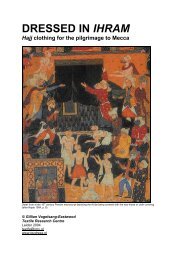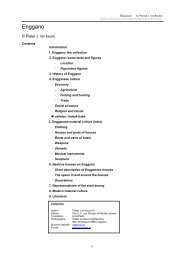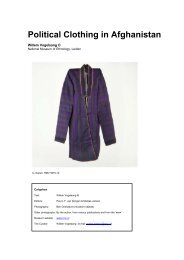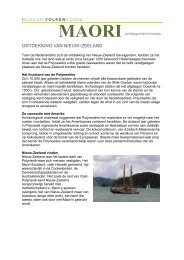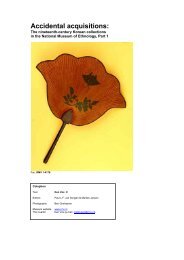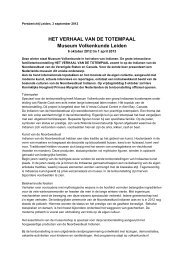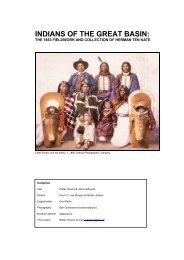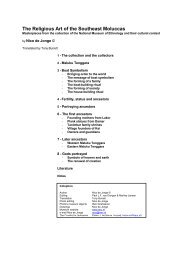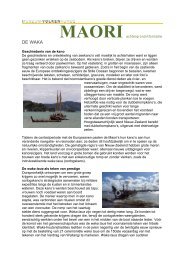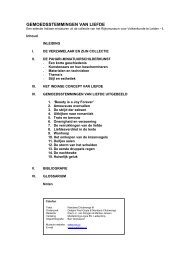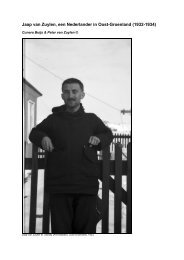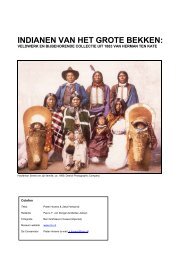PORSELEIN OM MEE TE SPELEN - Museum Volkenkunde
PORSELEIN OM MEE TE SPELEN - Museum Volkenkunde
PORSELEIN OM MEE TE SPELEN - Museum Volkenkunde
You also want an ePaper? Increase the reach of your titles
YUMPU automatically turns print PDFs into web optimized ePapers that Google loves.
<strong>PORSELEIN</strong> <strong>OM</strong> <strong>MEE</strong> <strong>TE</strong> <strong>SPELEN</strong>. PAUL VAN DONGEN ©<br />
Digitale publicaties van het Rijksmuseum voor <strong>Volkenkunde</strong><br />
andere objecten uit de antieke oudheid in permanente bruikleen gegeven. De porseleinen munten - bijna 1350 stuks<br />
- staan alle beschreven en afgebeeld in een catalogus getiteld. Sammlung Köhler-Osbahr, Band II/3. Vormünzliche<br />
Zahlungsmittel und Aussergewöhnliche Geldformen: Siamesische Porzellantoken. Duisburg 1995.<br />
72 Althoff 1995:29-30<br />
73 Donnelly 1969:209 De gehanteerde marge - 1000 tot 2000 - is dermate groot dat enige twijfel bestaat rond de<br />
juistheid van de genoemde aantallen.<br />
74 The decoration of the Peacock's Feather was granted for meritorious services, and, like many other orders, was<br />
also obtainable by purchase, or as a reward for contributing to charity. These feathers had either three, two, or a<br />
single "eye," or circular marking, according to the grade conferred. No doubt this use of the plumes caused a large<br />
annual consumption of the bird. […]<br />
The beautiful daughter of Tou I - a military commander in A.D. 562 - painted a peacock on a screen, and offered to<br />
marry the man who was able to hit the bird twice running with an arrow. The first Emperor of the T'ang dynasty put<br />
out both the eyes of the bird with his shots, and was therefore declared the successful suitor. Hence "selection by<br />
hitting the bird screen" has become a synonym for choosing a husband. (Williams 1976:317-8)<br />
75 Williams 1976:185.<br />
76 Source: http://www.gotheborg.com/glossary/symbolsindex.htm<br />
77 Zie hoofdstuk 4, 'Roulerende schatten'.<br />
78 Althoff 1995:34<br />
79 Bij hun weergave van een bepaalde waardeaanduiding gebruiken de Chinezen naast volledige karaktertekens<br />
regelmatig ook standaard afgekorte karakters of varianten uit een soort handelsstenografie.<br />
80 Zie G. Hollink ONS 121en Althoff's catalogus van de Köhler-Osbahr collectie.<br />
81 Hollink ONS 121.<br />
82 Hollink ONS 121.<br />
83 Dit zijn vier bijzondere begrippen uit de Yijing, het `Boek der Veranderingen'. De Yijing is één van de zogenoemde<br />
de Wu Jing, de "Vijf Klassieken". Dit zijn vijf belangrijke boekwerken uit tweede eeuw voor Christus waarin oude(re)<br />
filosofische en historische teksten zijn opgenomen. De Yijing kenmerkt zich vooral door de vele metafysische en<br />
kosmologische speculaties - waaronder die rond de 'acht trigrammen' - die er in aan de orde komen.<br />
84 Gustaaf Schlegel noemt in voorkomende gevallen deze tekens in het Duits Handelszeichen of Handelsstempel.<br />
85 Beide namen zijn ook te vinden op porseleinen munten in andere collecties, die gepubliceerd zijn door Ramsden<br />
en Althoff.<br />
42



